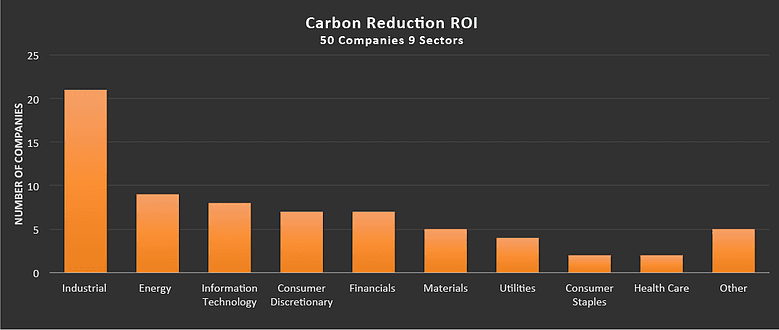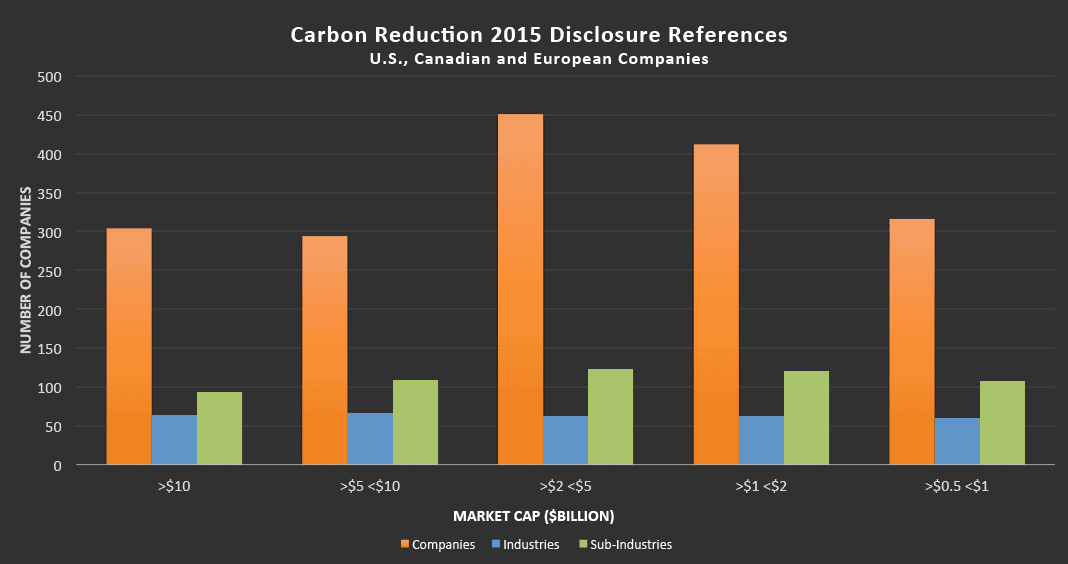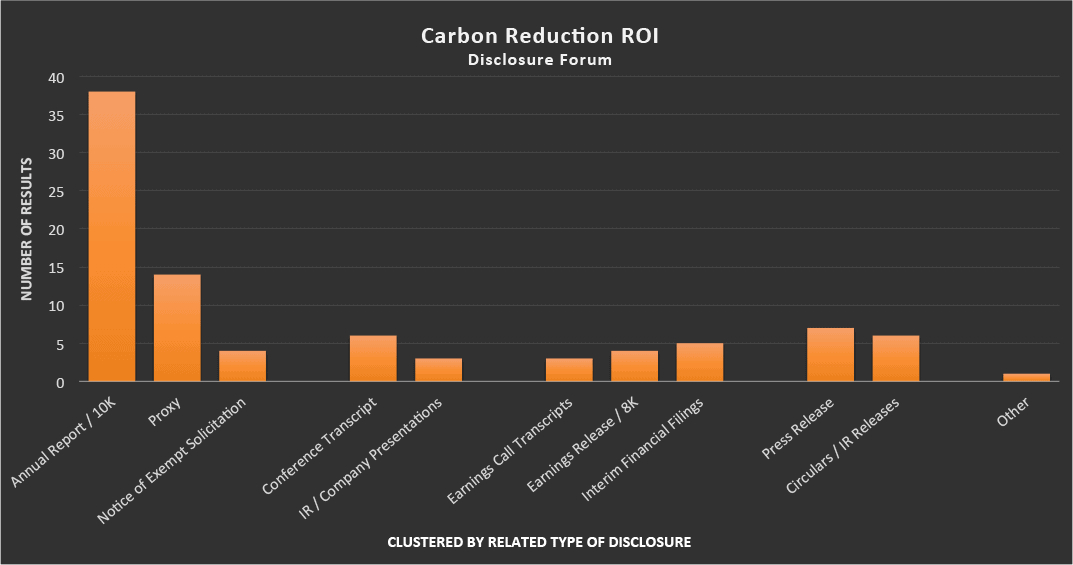Carbon reduction is a hot topic in the ESG/Sustainability field for investor consideration as well as in the general public discourse. The Carbon Disclosure Project (CDP), Global Reporting Initiative (GRI) and other influencers have encouraged companies to disclose their commitment and progress toward carbon reduction. Growing numbers of asset owners and managers are using inclusionary ESG / Sustainability investment strategies to select companies that are prudently managed to achieve carbon performance improvement and other environmental or energy related performance.
Sustainability is the umbrella term that encompasses many associated acronyms. ESG is the acronym commonly used in the U.S., while in the UK and Europe, SRI (Socially Responsible Investing) or CSR (Corporate Social Responsibility) are more common.
ESG = Environmental & Energy, Social Responsibility and Governance
How is the corporate carbon performance record influencing disclosure to the financial community? Are companies able to track returns on their investment in carbon reduction, or is it simply a cost to achieve carbon reduction? Is carbon reduction being used in positioning by companies to compete for desired customers and investors?
I used AlphaSense to test these questions and to make observations, highlights of which I shared with you below, followed by supporting data in the In Practice section.
Financial disclosure
Carbon reduction in context with return on investment and competitive positioning is clearly on the minds of company management, as validated by their disclosures to the financial community. This is based on 50 companies in 9 sectors found using an AlphaSense query.

The most frequent forum for disclosure used by these companies was annual reports and 10Ks.
The next most frequent forums were the proxy and Notice of Exempt Solicitation — used by shareholders to raise the subject, as permitted by the SEC.
The 50 companies identified by my query created a concise group. A more basic query on just “carbon reduction” resulted in over 600 companies (see In Practice below). Given the trends identified during my research for this blog alone, it is reasonable to project that more companies will gravitate toward adding carbon reduction ROI into traditional disclosure.
Return on investment
Starting with a search of company-initiated disclosure, the results appear dominated by systems and component suppliers to companies looking to achieve carbon reduction. However, my search did pick up several interesting purchasing company disclosures.
Here are the germane excerpts pulled by AlphaSense:
The supplier companies discussed carbon reduction in terms of installed system / project improvement and ROI, measurement, efficiency and regulatory driven business, financial incentives and feed-in tariffs, etc.
For example:
American DG Energy [$ADGE] – Press Release, January 23, 2014
American DG Energy to Oversee Complete Energy Plant Conversion
“Upon completion, the DoubleTree Suites by Hilton New York City – Times Square is expected to achieve significant energy cost savings, reduce their carbon footprint by 2,208 tons annually, and generate attractive return on incremental invested capital.”
The purchasing companies discussed reducing carbon emissions across the value chain, reduction in energy usage and carbon intensity and impressive reductions and cost savings with attractive ROI.
For example:
Host Hotels & Resorts Inc. [$HST] – 10K, March 1, 2010
“These projects also include green initiatives at our properties designed to increase energy efficiency and decrease our properties’ overall carbon footprint. In certain instances, these ROI / repositioning projects have coincided with the timing of regular maintenance cycles at the properties where we have used the opportunity to significantly improve and upgrade the hotel.”Office Depot Inc. [$ODP] – Press Release, March 12, 2013
“We’ve made a series of fiscally sound investments in energy efficiency that have far exceeded our investment performance requirements, delivered rapid ROI, and reduced our carbon footprint substantially. By achieving our carbon reduction goal, we’ve proven again that there doesn’t need to be a conflict between economic and environmental goals — you just have to choose to invest in the right things.”C&C Group Holdings plc [$CP.IE] – Annual Report, 2014
“This [recyclable keg innovation] eliminates transportation of empty steel kegs back to the UK and ROI, and will significantly reduce the Group’s overall carbon footprint.”
Eleven of the 50 companies had shareholder proxy proposals or notice of exempt solicitations in which a 2013 report by CDP, “The 3% Solution: Driving Profits Through Carbon Reduction” was highlighted. The CDP report outlines the results of a 6-year study of 386 U.S. companies in the S&P 500 (an 80% response rate), in order to emphasize the growing importance of carbon reduction to financial performance. The CDP report demonstrates there is a larger universe of companies focusing on this performance.
The study identified that 79% of U.S. companies in the S&P 500, “earn a higher return on their carbon reduction investments than on their overall corporate capital investments.” It also found the highest returns were energy efficiency improvements that earned an average return on investment of 196% with an average payback period of 2 to 3 years.
Interestingly, CDP indicated in its report that carbon investment as a percent of CAPEX ranged from an average of 4% (for companies that did not set carbon targets) to 12% (for companies that set carbon targets). It also emphasized that opportunities to profitably reduce carbon emissions vary by sector and supply chain. So what might cause companies to provide such sustainability information to CDP, but not directly to the financial community?
For company management and investor relations officers reading this blog post:
You should be aware that at last count in 2015, CDP is backed by 822 institutional investor members, representing in excess of $95 trillion in assets under management; they have access to software enabling easy analysis of company responses to CDP.[4]
For investors reading this blog post:
You should know that in September 2015, CDP observed a threefold increase in 1 year of the number of companies reporting that they have begun to price carbon — suddenly climbing to 437 companies from 150 companies in 2014.[5]
Two other interesting references were made in the shareholder proposals:
In its May 2015 proxy, Emerson Electric Company [$EMR] included: “Presently, 60 percent of Fortune 100 companies have GHG reduction commitments, renewable energy commitments, or both. Also, the 53 Fortune 100 companies reporting on climate and energy targets to CDP are saving $1.1 billion annually through their emission reductions and renewable energy initiatives.”
The shareholder proposal did not indicate their source, but it appears these facts came from a Ceres report, “Power Forward 2.0 – How American Companies are Setting Clean Energy Targets and Capturing Greater Business Value.” [6] There is a lot more in this report both for investors and corporate management alike.
In its April 2013 proxy, CF Industries Holdings Inc. [$CF] a shareholder proposal pointed to the successes of the well-known sustainability leader, Johnson & Johnson [$JNJ]: “We believe energy use is one of the most manageable operating costs for many companies. For instance, Johnson & Johnson has invested $187 million since 2005 in generally low-risk energy efficiency projects, reducing carbon dioxide emissions by 129,000 metric tons annually, providing an internal annual return on investment of nearly 19%.”
The mix of AlphaSense query results is interesting in itself and consistent with the fact that traditional disclosure decisions are regularly prioritized based on materiality thresholds. But, if we can rely on these CDP and Ceres reports that suggest growing evidence of carbon reduction ROI, it will be interesting to watch as more “purchasing” companies expand disclosure of carbon reduction ROI into traditional disclosure documents. For now, it appears that we still have to look for the information mostly in sustainability reports and direct reporting to CDP.
Competitive positioning
Seven of the 11 companies’ shareholder comments that highlighted the CDP report conveyed beliefs and concerns that the company was lagging its peers in carbon reduction and ROI.
If I were an analyst or money manager, my attention would be piqued, since it is likely a good signal that these companies should be looking at how they can improve their competitive positioning and ROI on carbon reduction. Company management is also likely examining where they can improve disclosure related to their carbon reduction ROI successes for more favorable public perception and to aid in competing for customers and investors. This is just one hot topic in the ESG / Sustainability field, but the strategic opportunities are interesting.
Approach
I wanted to see if AlphaSense could be used to identify U.S., Canadian and European companies that are including carbon reduction in their disclosures to the financial community. My initial “carbon reduction” query produced over 1,000 results, 607 companies, 12 sectors, 60 industries and 118 sub-industries captured by AlphaSense. Further study of this result might pare the number down, but nonetheless, the number of companies that are conveying their carbon reduction positioning in standard disclosure to the investment community is impressive. I quickly narrowed my query and results to “carbon reduction AND return on investment” for the focus of this blog.
In Practice
- 11 companies’ shareholders referenced the CDP report:
| Energy & Utility Sector | Other Sectors |
| Exxon Mobile Corp. [$XOM] | DISH Network [$DISH] |
| Marathon Petroleum Corp. [$MPC] | Gilead Sciences Inc. [$GILD] |
| Ultra Petroleum Corp. [$UPL] | Time Warner Inc. [$TWX] |
| Valero Energy Corp. [$VLO] | JM Smucker Co. [$SJM] |
| Holly Frontier Corp. [$HFC] | Oracle Corp. [$ORCL] |
| Emerson Electric [$EMR] |
It seems significant to point out that more than half of these companies are energy and utility sector companies and that the sector has the second highest representation in my query results (see chart above). Perhaps the inclusionary sustainability investors are onto something that the exclusionary (or divestment) investment strategies are missing out on for portfolio returns, since they are bothering to press the sector on the subject.
The number of industries that reference carbon reduction in public disclosure to the financial community is fairly consistent across market cap size. This is the one result I will show from my first query just on “carbon reduction,” so you can see where the 607 companies fall in market cap size:
Pamela Styles is principal of Next Level Investor Relations LLC, an Investor Relations consultancy with dual IR and ESG/Sustainability specialties.






